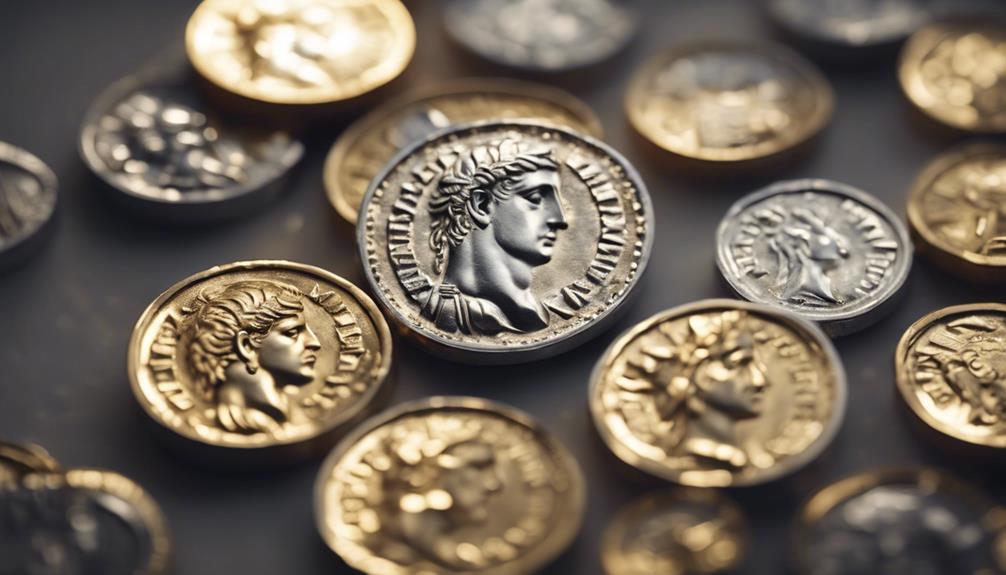Precious metals such as gold, silver, platinum, and palladium have a rich history as symbols of wealth and a reliable store of value. They are seen as dependable investments during times of economic uncertainty, thanks to their intrinsic value and liquidity. Adding these metals to a diversified portfolio can help manage risks and boost stability. Their industrial uses, especially in electronics and automotive sectors, fuel global demand for these metals. Sustainable mining practices are addressing environmental concerns. Future trends suggest that gold and silver will continue to be viewed as safe-haven assets, maintaining their value. Appreciating the significance of precious metals involves understanding their various roles in both economies and investment portfolios.
Key Takeaways
- Precious metals like gold and silver have intrinsic value and serve as reliable stores of wealth.
- They offer a hedge against inflation, currency devaluation, and economic instability.
- Precious metals provide diversification benefits and stability in investment portfolios.
- Global demand for precious metals is driven by jewelry, technology, and investment sectors.
- Central banks and governments hold substantial gold reserves, increasing the demand for these metals.
Historical Significance of Precious Metals

Throughout the annals of human history, the importance and profoundness of precious metals such as gold and silver have remained steadfast, transcending time and cultures. These metals have been treasured for their beauty, rarity, and intrinsic value. Gold, in particular, has been used as a form of currency and a symbol of wealth dating back to ancient civilizations like the Lydians in 550 BC. Silver, with its lustrous appearance and versatility, has also played a pivotal role in various aspects of human society, from adornments to currency.
The historical significance of these precious metals extends beyond mere aesthetics and practical uses. In times of economic uncertainty, gold and silver have served as a reliable store of value, providing a hedge against inflation and market volatility. The influx of gold and silver from the Americas by the Spanish conquistadors in the 16th century had a profound impact on global trade and wealth distribution. These metals have influenced economies, shaped empires, and symbolized power throughout history, making them essential components of human civilization.
Store of Value and Investment

Precious metals, such as gold and silver, have long served as a steadfast store of value and investment option for individuals seeking to preserve their wealth amidst economic uncertainties and market fluctuations. Investors often turn to gold and silver during times of economic instability as these metals have a history of retaining their value and acting as a hedge against inflation. Their intrinsic value, stemming from rarity, durability, and universal acceptance, makes them highly desirable assets worldwide. Gold and silver have also shown resilience over the long term, outperforming many other asset classes and making them attractive choices for diversifying investment portfolios.
| Gold | Silver |
|---|---|
| Store of Value | Store of Value |
| Investment | Investment |
| Hedge against Inflation | Hedge against Inflation |
Owning physical gold and silver provides investors with the opportunity to benefit directly from price appreciation and offers a tangible asset that can be easily liquidated when necessary.
Economic Hedge and Diversification

Investing in precious metals can act as a safeguard against inflation and currency devaluation, providing a hedge to protect wealth during economic uncertainties.
By diversifying portfolios with assets like gold and silver, investors can manage risks and enhance long-term returns through strategic asset allocation.
This approach not only helps in mitigating market volatility but also serves as a reliable strategy for wealth preservation over time.
Hedging Against Inflation
During times of economic uncertainty, the strategic allocation of precious metals serves as a reliable hedge against inflation, offering both stability and diversification to investors. Gold and silver are known for their ability to preserve wealth and provide a safe haven during periods of high inflation. Diversifying a portfolio with precious metals helps protect against economic uncertainties and currency devaluation. Historical data supports the notion that precious metals tend to perform well in times of economic instability. Investors seeking to safeguard their assets and hedge against inflation often turn to precious metals as a tangible asset with intrinsic value. This strategic move can counter the effects of inflation and volatility in traditional financial markets.
| Benefits of Precious Metals | Examples |
|---|---|
| Inflation Hedge | Gold, Silver |
| Wealth Preservation | Portfolio Diversification |
Portfolio Risk Management
In the domain of wealth management, effective portfolio risk management hinges on the strategic integration of economic hedges and diversification techniques.
When considering portfolio risk management, incorporating gold and silver can be beneficial due to their intrinsic value and stability.
To enhance portfolio resilience, diversifying with precious metals offers a counterbalance to traditional assets such as stocks and bonds.
During economic uncertainty, the value of gold and silver tends to increase, acting as a shield for investors.
By holding a portion of assets in precious metals, losses in other areas can be offset, boosting overall stability.
Including gold and silver in a diversified investment strategy helps safeguard wealth, providing protection against inflation and currency devaluation.
Asset Allocation Strategy
When structuring an asset allocation strategy focused on economic hedge and diversification, the inclusion of precious metals such as gold and silver plays a pivotal role in mitigating portfolio risk and enhancing overall stability. These metals, including platinum and palladium, offer a tangible store of value that tends to perform well during economic uncertainties. By incorporating gold, silver, platinum, or palladium into your asset allocation strategy, you can balance the volatility of traditional investments like stocks and bonds. The table below highlights the key characteristics of these precious metals:
| Precious Metal | Economic Hedge | Diversification Benefits |
|---|---|---|
| Gold | Yes | Yes |
| Silver | Yes | Yes |
| Platinum | Yes | Yes |
| Palladium | Yes | Yes |
Global Demand for Precious Metals

The global demand for precious metals is propelled by diverse industries such as jewelry, technology, and investment. This demand manifests in several key ways:
- Jewelry Sector: The allure of gold and silver in the jewelry sector remains a significant driver of global demand, particularly in countries like India and China, where these metals hold cultural and economic significance. The craftsmanship and intrinsic value of these metals continue to attract consumers worldwide.
- Technology Industry: Precious metals such as platinum, palladium, and silver play an essential role in the technology industry, where they are vital for electronic components and catalytic converters. The demand for these metals in cutting-edge technologies underscores their irreplaceable nature in advancing various sectors.
- Investment Demand and Reserve Assets: The investment demand for precious metals has surged amidst economic uncertainties, geopolitical tensions, and the need for inflation hedging. Additionally, central banks and governments hold substantial amounts of gold as part of their reserve assets, further bolstering the global demand for these precious metals.
Precious Metals in Financial Markets

Precious metals, such as gold and silver, play a significant role in financial markets globally. Their market impact is profound, offering investors a safe haven during times of economic uncertainty.
Additionally, these metals hold great potential for investment and are commonly used to diversify portfolios and hedge against inflation and currency risks.
Market Impact of Metals
Amidst economic uncertainties, the market impact of precious metals like gold, silver, platinum, and palladium in financial markets remains significant.
- Price Fluctuations: The value of these metals is influenced by various factors such as inflation, interest rates, geopolitical events, and market speculation.
- Investment Demand: Gold, known for its stability, is often sought after by investors as a safe-haven asset and a hedge against currency devaluation.
- Industrial Demand and Supply-Demand Dynamics: Silver's market impact is driven not only by investment demand but also by its industrial applications. Platinum and palladium, vital in the automotive industry for catalytic converters, see price fluctuations based on supply-demand dynamics and economic conditions.
Investment Potential of Metals
During times of economic uncertainty, the allure of precious metals as an investment option in financial markets stems from their intrinsic value and historical stability. Gold, silver, platinum, and palladium are considered safe-haven assets that offer a hedge against inflation and preserve wealth over time.
Silver's dual role as an industrial metal and store of value makes it sensitive to economic cycles. Platinum and palladium, primarily used in the automotive industry, also have investment potential.
The appeal of precious metals lies in their ability to diversify a portfolio, protect against currency devaluation, and provide a tangible asset during market volatility. Investors looking for stability and a way to hedge risks often turn to precious metals for their investment potential in turbulent economic climates. Their historical track record of preserving value makes them a sought-after choice during periods of inflation or geopolitical uncertainty. Gaining precious metals market insights can help investors identify trends, understand supply and demand dynamics, and make informed decisions about their investments. By staying informed, individuals can better align their financial goals with the unique benefits that precious metals bring to a diversified portfolio.
Role in Portfolio Diversification
In the domain of financial markets, the inclusion of precious metals in investment portfolios serves as a strategic measure to diversify risk and enhance long-term returns. Precious metals like gold and silver offer a hedge against market volatility and inflation, making them valuable assets for safeguarding wealth.
The low correlation these metals exhibit with traditional financial assets further solidifies their role in portfolio diversification. By adding gold, silver, platinum, or palladium to a portfolio, investors can spread risk and preserve purchasing power over time.
Allocating a portion of investments to precious metals can provide a safety net during economic downturns, offering stability and potential growth in the face of currency devaluation and geopolitical uncertainties.
Industrial Applications of Precious Metals

The industrial applications of precious metals encompass a wide range of sectors, from electronics to automotive, showcasing their indispensable role in modern technological advancements.
Silver is highly valued for its industrial applications in electronics, solar panels, and medical devices, thanks to its exceptional conductivity and resistance to corrosion.
Platinum plays an important role in catalytic converters, aiding in the reduction of harmful emissions from vehicles and industrial processes.
Gold finds its place in various industrial uses like electronics, aerospace components, and medical devices due to its excellent conductivity and corrosion resistance.
Palladium is essential in catalytic converters, particularly in gasoline-powered vehicles, where it helps convert harmful pollutants into less harmful emissions.
Precious metals are also critical in cutting-edge technologies such as fuel cells, hydrogen production, and advanced manufacturing processes, highlighting their significance beyond traditional investment purposes.
The versatility and unique properties of these metals make them invaluable in driving innovation and sustainability in various industries.
Environmental Impact of Mining Precious Metals

The environmental impact of mining precious metals extends beyond the extraction process, encompassing habitat destruction, water contamination, and air pollution. When mining precious metals, the consequences are far-reaching, with toxic chemicals such as cyanide and mercury posing serious risks to ecosystems and human health. The effects of such mining activities include deforestation, soil erosion, and the disruption of local communities. Additionally, the waste materials from mining operations, known as tailings, can release harmful substances into the environment, affecting water quality and biodiversity.
- Habitat destruction
- Use of toxic chemicals
- Impact on local communities
To address these issues, sustainable mining practices are being developed. These initiatives aim to minimize the environmental footprint associated with extracting precious metals, promoting a more responsible approach to mining that balances resource needs with environmental preservation. By adopting sustainable mining practices, the industry can work towards mitigating the negative environmental impact of mining precious metals.
Future Outlook for Precious Metals

Amidst evolving market dynamics, the anticipated trajectory for precious metals underscores their enduring significance in investment portfolios. Market analysts foresee a positive future outlook for platinum and palladium, primarily due to their industrial applications in sectors such as automotive and technology. The demand for these metals is expected to rise as they continue to be crucial components in various manufacturing processes.
Additionally, with increasing economic uncertainties and the potential for inflation, precious metals like gold and silver are likely to maintain their value as traditional safe-haven assets.
Factors such as geopolitical tensions and global economic conditions can greatly impact the future prices of precious metals, making them appealing for investors seeking diversification and stability. Continued central bank policies and the risk of currency devaluation further support the long-term growth potential of these metals.
As investors navigate through uncertain times, the allure of precious metals as a hedge against economic instability remains a compelling reason to contemplate including them in investment portfolios.
Frequently Asked Questions
What Is the Current Price of Precious Metals?
The current prices of precious metals fluctuate due to market demand, geopolitical events, and economic indicators.
Gold is approximately $1,800 per ounce, silver is trading around $25 per ounce, platinum is priced at about $1,100 per ounce, and palladium is valued at around $2,400 per ounce.
These prices are subject to change based on various factors impacting the precious metals market.
What Is the Order of Value of Precious Metals?
The order of value of precious metals typically follows a traditional hierarchy with gold at the top, followed by platinum, palladium, and then silver. The value of these metals can vary based on factors like rarity, industrial uses, and market demand.
Gold's historical significance, rarity, and aesthetic appeal have long made it the most valuable precious metal. Platinum, due to its rarity and industrial applications, often commands a higher value than silver. Gold has also been a symbol of wealth and status across cultures, influencing economies and traditions for centuries. The intricate process of mining and refining adds to its allure, creating a consistent demand in both investment and jewelry markets. Furthermore, understanding gold quarter rarity can provide collectors and investors with insights into unique pieces that hold both historical and monetary value.
Which Precious Metal Is Worth the Most?
Platinum typically holds the title of the most valuable precious metal. Its rarity, industrial uses, and historical pricing trends contribute to its premium position in the market.
Investors often view platinum as a store of value and a hedge against economic uncertainties. Its unique properties and relative scarcity make it a sought-after commodity, commanding higher prices compared to other precious metals like gold, silver, and palladium.
How Much Does 1 Gram of Metal Cost?
The cost of 1 gram of metal varies depending on the type of metal being considered. Gold, silver, platinum, and palladium each have distinct market prices, with platinum and palladium generally being more expensive than gold and silver.
These prices are influenced by factors such as supply, demand, and economic conditions. As a result, the price of 1 gram of metal can fluctuate throughout the day based on these market dynamics.
Conclusion
To sum up, the value of precious metals cannot be overemphasized. With their historical significance, store of value, economic hedge, global demand, and industrial applications, these metals play a vital role in various sectors.
Despite the environmental impact of mining, the future outlook for precious metals remains promising. Investors and industries alike continue to rely on these valuable assets for stability and growth, making them an essential component of our modern economy.











